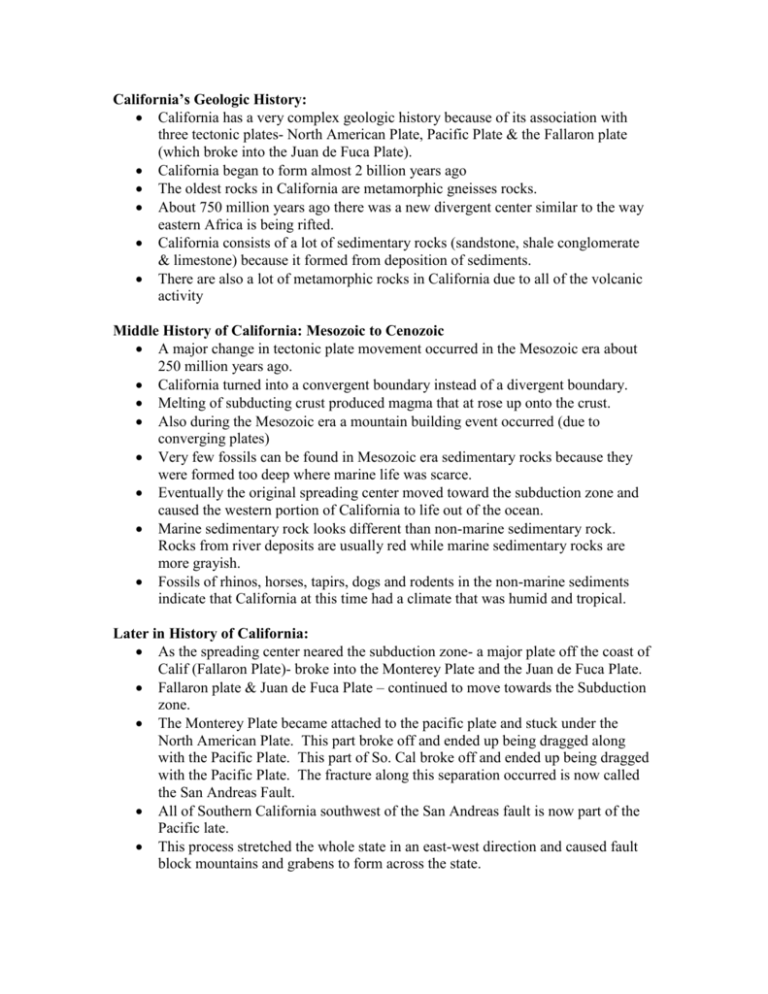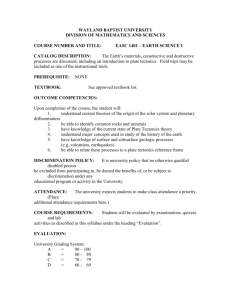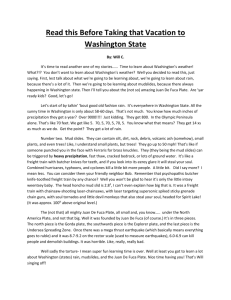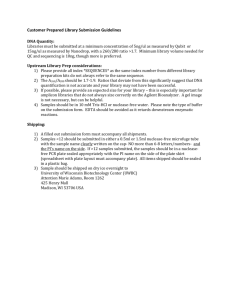California`s Geologic History:
advertisement

California’s Geologic History: California has a very complex geologic history because of its association with three tectonic plates- North American Plate, Pacific Plate & the Fallaron plate (which broke into the Juan de Fuca Plate). California began to form almost 2 billion years ago The oldest rocks in California are metamorphic gneisses rocks. About 750 million years ago there was a new divergent center similar to the way eastern Africa is being rifted. California consists of a lot of sedimentary rocks (sandstone, shale conglomerate & limestone) because it formed from deposition of sediments. There are also a lot of metamorphic rocks in California due to all of the volcanic activity Middle History of California: Mesozoic to Cenozoic A major change in tectonic plate movement occurred in the Mesozoic era about 250 million years ago. California turned into a convergent boundary instead of a divergent boundary. Melting of subducting crust produced magma that at rose up onto the crust. Also during the Mesozoic era a mountain building event occurred (due to converging plates) Very few fossils can be found in Mesozoic era sedimentary rocks because they were formed too deep where marine life was scarce. Eventually the original spreading center moved toward the subduction zone and caused the western portion of California to life out of the ocean. Marine sedimentary rock looks different than non-marine sedimentary rock. Rocks from river deposits are usually red while marine sedimentary rocks are more grayish. Fossils of rhinos, horses, tapirs, dogs and rodents in the non-marine sediments indicate that California at this time had a climate that was humid and tropical. Later in History of California: As the spreading center neared the subduction zone- a major plate off the coast of Calif (Fallaron Plate)- broke into the Monterey Plate and the Juan de Fuca Plate. Fallaron plate & Juan de Fuca Plate – continued to move towards the Subduction zone. The Monterey Plate became attached to the pacific plate and stuck under the North American Plate. This part broke off and ended up being dragged along with the Pacific Plate. This part of So. Cal broke off and ended up being dragged with the Pacific Plate. The fracture along this separation occurred is now called the San Andreas Fault. All of Southern California southwest of the San Andreas fault is now part of the Pacific late. This process stretched the whole state in an east-west direction and caused fault block mountains and grabens to form across the state. In Southern California the motion of the pacific plate caused a portion of southern California to rotate more than 90 degrees – this is part of the ventura county area. About 2 million years ago the climate became much cooler causing glaciers to form in the mountains The erosion of valleys beneath the glaciers resulted in steepened side slopes and widened valley bottoms- which created broad U shaped valleys.







